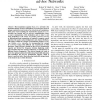Free Online Productivity Tools
i2Speak
i2Symbol
i2OCR
iTex2Img
iWeb2Print
iWeb2Shot
i2Type
iPdf2Split
iPdf2Merge
i2Bopomofo
i2Arabic
i2Style
i2Image
i2PDF
iLatex2Rtf
Sci2ools
CORR
2010
Springer
2010
Springer
Two-Way Transmission Capacity of Wireless Ad-hoc Networks
The transmission capacity of an ad-hoc network is the maximum density of active transmitters in an unit area, given an outage constraint at each receiver for a fixed rate of transmission. Most prior work on finding the transmission capacity of ad-hoc networks has focused only on one-way communication where a source communicates with destination and no data is sent from destination to the source. In practice, however, two-way or bidirectional data transmission is required to support control functions like packet acknowledgements and channel feedback. This paper extends the concept of transmission capacity to twoway wireless ad-hoc networks, by incorporating the concept of a two-way outage with different rate requirements in both directions. Upper and lower bounds on the two-way transmission capacity are derived for frequency division duplexing, under the assumption that the channel coefficients are independent on different carrier frequencies. The derived bounds are used to derive the o...
| Added | 01 Mar 2011 |
| Updated | 01 Mar 2011 |
| Type | Journal |
| Year | 2010 |
| Where | CORR |
| Authors | Rahul Vaze, Kien T. Truong, Steven Weber, Robert W. Heath Jr. |
Comments (0)

